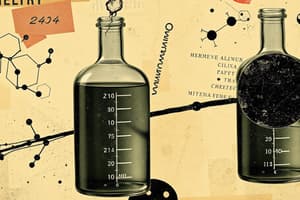Podcast
Questions and Answers
What is the primary factor that influences the proportions of PO43-, HPO42- and H2PO4- ions in solution?
What is the primary factor that influences the proportions of PO43-, HPO42- and H2PO4- ions in solution?
- pH value (correct)
- Eh
- Salinity
- Concentration of phosphorus
What is the term used to cumulatively indicate the various phosphorus species determined with the ammonium heptamolybdate method?
What is the term used to cumulatively indicate the various phosphorus species determined with the ammonium heptamolybdate method?
- Total Phosphorus
- Organic Phosphorus
- Reactive Phosphorus (RP) (correct)
- Inorganic Phosphorus
What is the purpose of adding sulfuric acid (H2SO4) in the reaction mixture?
What is the purpose of adding sulfuric acid (H2SO4) in the reaction mixture?
- To stabilize the mixed reagent
- To create an acid medium (correct)
- To catalyze the reaction
- To reduce the phosphomolybdic complex
What is the wavelength at which the absorbance is measured in the phosphorus determination method?
What is the wavelength at which the absorbance is measured in the phosphorus determination method?
What is the function of antimonyl potassium tartrate in the reaction mixture?
What is the function of antimonyl potassium tartrate in the reaction mixture?
What is the ratio of the mixed reagent to the sample volume?
What is the ratio of the mixed reagent to the sample volume?
How long is the mixed reagent stable for before it needs to be reprepared?
How long is the mixed reagent stable for before it needs to be reprepared?
What is the purpose of ascorbic acid in the reaction mixture?
What is the purpose of ascorbic acid in the reaction mixture?
Flashcards are hidden until you start studying
Study Notes
Phosphorus in Water
- Phosphorus compounds or orthophosphate ions (PO4) exist in solution in different proportions of PO43-, HPO42-, and H2PO4- ions, depending on pH, Eh, salinity, and temperature.
Determination of Phosphorus
- The most commonly used method for determining phosphorus employs ammonium heptamolybdate, which extracts inorganic ions and a fraction of organic orthophosphates.
- This method cumulatively indicates the various phosphorus species as "reactive phosphorus (RP)".
Expression of Phosphorus Concentration
- When expressing the concentration of orthophosphate ions or RP, it refers to the concentration of the element phosphorus alone.
- Many authors prefer to indicate the concentration of phosphorus with symbols such as P-PO4.
Method of Analysis
- The method is based on the reaction of orthophosphate with ammonium molybdate in an acid medium (sulfuric acid).
- The reaction forms a yellow phosphomolybdic complex.
- The complex is then reduced with ascorbic acid to a strongly colored blue compound, catalyzed by the antimonyl ion (SbO+).
- Absorbance is measured at a wavelength of 885 nm.
Reagents
- Ammonium heptamolybdate: 3g in 100 ml of distilled water.
- Sulfuric acid (H2SO4): 14 ml + 90 ml of distilled water (total volume 104 ml).
- Ascorbic acid: 5.4 g in 100 ml of distilled water.
- Antimonyl potassium tartrate: 0.136 g in 100 ml of distilled water.
- Mixed Reagent: combine reagents in the order shown, in a ratio of 1:2.5:1:0.5.
- Mixed Reagent is stable for about 6 hours and must be added to samples in a volumetric proportion of 10%.
Studying That Suits You
Use AI to generate personalized quizzes and flashcards to suit your learning preferences.




